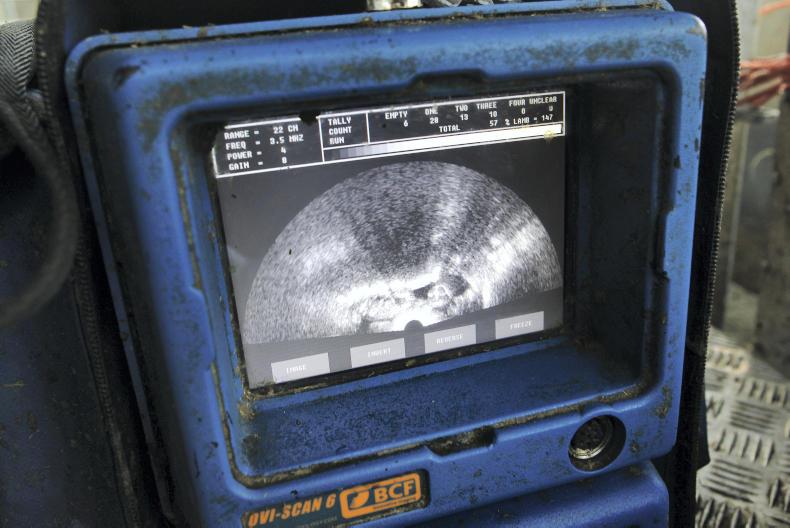The measure of pregnancy scanning ewes is one of the most common measures selected by those participating in the Sheep Welfare Scheme. As such, there are currently lots of questions being raised among farmers with the most common of these addressed below.
1 Do I need to implement a particular feeding programme or change my current feeding programme?The current feeding programme in place does not need to be altered as long as it is delivering on the target of improving lamb survivability and reducing mortality.
2 Table 1 in the Sheep Welfare Scheme action booklet lists a supplementation rate for different litter sizes. My single-bearing ewes are in better condition this year and I plan not to supplement with concentrates and possibly offer feed buckets in late pregnancy. Is this allowed?
Yes, where no supplementation is being offered it should be recorded as zero. In the case of a Department inspection, grass, hay or silage availability and ewe condition may be examined to ascertain if the feeding programme is sufficient. Where feed buckets are being used, which is common in hill flocks, then this should be recorded in the action book with a record retained of the number of feed buckets offered and the number of ewes fed.
3 The table listed in the action book includes a feeding rate per head per day. Does this mean a flat-rate feeding programme needs to be used? There is no need to apply a flat-rate feeding programme. A rising level of supplementation can be used as long as it is recorded. 4 Can ewes with varying litter sizes be fed in one group post scanning?The benefit of scanning is that it allows ewes to be grouped for appropriate feeding. There may be circumstances, however, where ewes with different litter sizes are mixed.
For example, where feeding high-quality silage there may not be a need to segregate ewes until supplementation is required.
Likewise, twin-bearing ewes in poor body condition are often grouped with triplet bearing ewes for additional supplementation as can single-bearing ewes requiring preferential treatment be grouped with twin bearing ewes.
The feeding programme which is delivering results can be continued.
5 Is there a date at which concentrate supplementation, feed buckets, molasses, etc, must be introduced?
There is no defined date. This will depend on the quality of forage as detailed in Table 3 in the main article and the condition of ewes.
The measure of pregnancy scanning ewes is one of the most common measures selected by those participating in the Sheep Welfare Scheme. As such, there are currently lots of questions being raised among farmers with the most common of these addressed below.
1 Do I need to implement a particular feeding programme or change my current feeding programme?The current feeding programme in place does not need to be altered as long as it is delivering on the target of improving lamb survivability and reducing mortality.
2 Table 1 in the Sheep Welfare Scheme action booklet lists a supplementation rate for different litter sizes. My single-bearing ewes are in better condition this year and I plan not to supplement with concentrates and possibly offer feed buckets in late pregnancy. Is this allowed? Yes, where no supplementation is being offered it should be recorded as zero. In the case of a Department inspection, grass, hay or silage availability and ewe condition may be examined to ascertain if the feeding programme is sufficient. Where feed buckets are being used, which is common in hill flocks, then this should be recorded in the action book with a record retained of the number of feed buckets offered and the number of ewes fed.
3 The table listed in the action book includes a feeding rate per head per day. Does this mean a flat-rate feeding programme needs to be used? There is no need to apply a flat-rate feeding programme. A rising level of supplementation can be used as long as it is recorded. 4 Can ewes with varying litter sizes be fed in one group post scanning?The benefit of scanning is that it allows ewes to be grouped for appropriate feeding. There may be circumstances, however, where ewes with different litter sizes are mixed.
For example, where feeding high-quality silage there may not be a need to segregate ewes until supplementation is required.
Likewise, twin-bearing ewes in poor body condition are often grouped with triplet bearing ewes for additional supplementation as can single-bearing ewes requiring preferential treatment be grouped with twin bearing ewes.
The feeding programme which is delivering results can be continued.
5 Is there a date at which concentrate supplementation, feed buckets, molasses, etc, must be introduced?There is no defined date. This will depend on the quality of forage as detailed in Table 3 in the main article and the condition of ewes.






 This is a subscriber-only article
This is a subscriber-only article










SHARING OPTIONS: